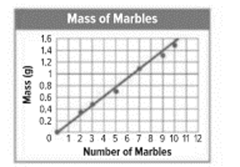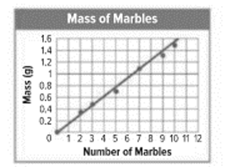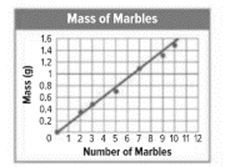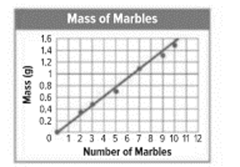
Concept explainers
(a)
To describe: The accuracy of the line.
(a)
Explanation of Solution
Given:
The graph of the mass of marbles is shown in Figure 1.

Figure 1
Each point on the graph shows the relation between the number of marble and its mass where the number of marbles is the independent variable and the mass is dependent variable.
The accuracy of the line depends on the closeness of the points to the line.
It can be seen from the given graph that some points are above the line and some are below the line and some are passing through.
The points are close to the line. Therefore, there is high
The points are closeto the line but all points donot pass through the line. In conclusion accuracy is quite good but not perfectly correct.
(b)
To find: The approximate mass of 7 marbles.
(b)
Answer to Problem 10PPS
The approximate mass of 7 marbles is 1.1g.
Explanation of Solution
Given:
The graph of the mass of marbles is shown in Figure 1.

Figure 1
The number of marbles is shown on the horizontal axis that is independent variable and the mass is shown on the vertical axis that is dependent variable.
See the point for 7 marbles on the graph.
It can be observed from Figure 1 that the approximate mass of 7 marbles is 1.1g.
Therefore, the approximate mass of 7 marbles is 1.1g.
(c)
To explain: The reason of few points is above the line and some are below the line.
(c)
Explanation of Solution
Given:
The graph of the mass of marbles is shown in Figure 1.

Figure 1
The set of points are the
The line of best fit is the line passes through the points or closely to the point. If half of the data points on the scatter point is below the line and half above the line.
It can be seen from Figure 1 that the data points come close to the line of the best fit that means the
The positive correlation is high since it predicts the values near the line some points are above the line and some are below the line.
(d)
To make: A conjecture for the approximate mass of 20 marbles and explain the reasoning.
(d)
Explanation of Solution
Given:
The graph of the mass of marbles is shown in Figure 1.

Figure 1
It can be observed from the Figure 1 that the possible set of points are represented in the below table.
| Number of marbles | Mass |
| 0 | 0 |
| 2 | 0.38 |
| 3 | 0.5 |
| 5 | 0.7 |
| 7 | 1.1 |
| 9 | 1.3 |
| 10 | 1.48 |
It can be seen that that the line of the regression is the form of
The point is 1.48 at the time of 10 marbles.
Therefore, there is possibility of the slope is 1.433 and the y- intercept is 0.05 something.
Substitute 1.433 for
Take these points for the line to make a conjecture for the 20 marbles.
Substitute 20 for
Therefore, it would be 2.433 something.
Chapter 1 Solutions
Algebra 1, Homework Practice Workbook (MERRILL ALGEBRA 1)
Additional Math Textbook Solutions
Elementary Statistics (13th Edition)
Calculus: Early Transcendentals (2nd Edition)
A Problem Solving Approach To Mathematics For Elementary School Teachers (13th Edition)
University Calculus: Early Transcendentals (4th Edition)
Pre-Algebra Student Edition
- Safari File Edit View History Bookmarks Window Help Ο Ω OV O mA 0 mW ర Fri Apr 4 1 222 tv A F9 F10 DII 4 F6 F7 F8 7 29 8 00 W E R T Y U S D பட 9 O G H J K E F11 + 11 F12 O P } [arrow_forwardSo confused. Step by step instructions pleasearrow_forwardIn simplest terms, Sketch the graph of the parabola. Then, determine its equation. opens downward, vertex is (- 4, 7), passes through point (0, - 39)arrow_forward
- In simplest way, For each quadratic relation, find the zeros and the maximum or minimum. a) y = x 2 + 16 x + 39 b) y = 5 x2 - 50 x - 120arrow_forwardIn simplest terms and step by step Write each quadratic relation in standard form, then fi nd the zeros. y = - 4( x + 6)2 + 36arrow_forwardIn simplest terms and step by step For each quadratic relation, find the zeros and the maximum or minimum. 1) y = - 2 x2 - 28 x + 64 2) y = 6 x2 + 36 x - 42arrow_forward
- Write each relation in standard form a)y = 5(x + 10)2 + 7 b)y = 9(x - 8)2 - 4arrow_forwardIn simplest form and step by step Write the quadratic relation in standard form, then fi nd the zeros. y = 3(x - 1)2 - 147arrow_forwardStep by step instructions The path of a soccer ball can be modelled by the relation h = - 0.1 d 2 + 0.5 d + 0.6, where h is the ball’s height and d is the horizontal distance from the kicker. a) Find the zeros of the relation.arrow_forward
 Algebra and Trigonometry (6th Edition)AlgebraISBN:9780134463216Author:Robert F. BlitzerPublisher:PEARSON
Algebra and Trigonometry (6th Edition)AlgebraISBN:9780134463216Author:Robert F. BlitzerPublisher:PEARSON Contemporary Abstract AlgebraAlgebraISBN:9781305657960Author:Joseph GallianPublisher:Cengage Learning
Contemporary Abstract AlgebraAlgebraISBN:9781305657960Author:Joseph GallianPublisher:Cengage Learning Linear Algebra: A Modern IntroductionAlgebraISBN:9781285463247Author:David PoolePublisher:Cengage Learning
Linear Algebra: A Modern IntroductionAlgebraISBN:9781285463247Author:David PoolePublisher:Cengage Learning Algebra And Trigonometry (11th Edition)AlgebraISBN:9780135163078Author:Michael SullivanPublisher:PEARSON
Algebra And Trigonometry (11th Edition)AlgebraISBN:9780135163078Author:Michael SullivanPublisher:PEARSON Introduction to Linear Algebra, Fifth EditionAlgebraISBN:9780980232776Author:Gilbert StrangPublisher:Wellesley-Cambridge Press
Introduction to Linear Algebra, Fifth EditionAlgebraISBN:9780980232776Author:Gilbert StrangPublisher:Wellesley-Cambridge Press College Algebra (Collegiate Math)AlgebraISBN:9780077836344Author:Julie Miller, Donna GerkenPublisher:McGraw-Hill Education
College Algebra (Collegiate Math)AlgebraISBN:9780077836344Author:Julie Miller, Donna GerkenPublisher:McGraw-Hill Education





